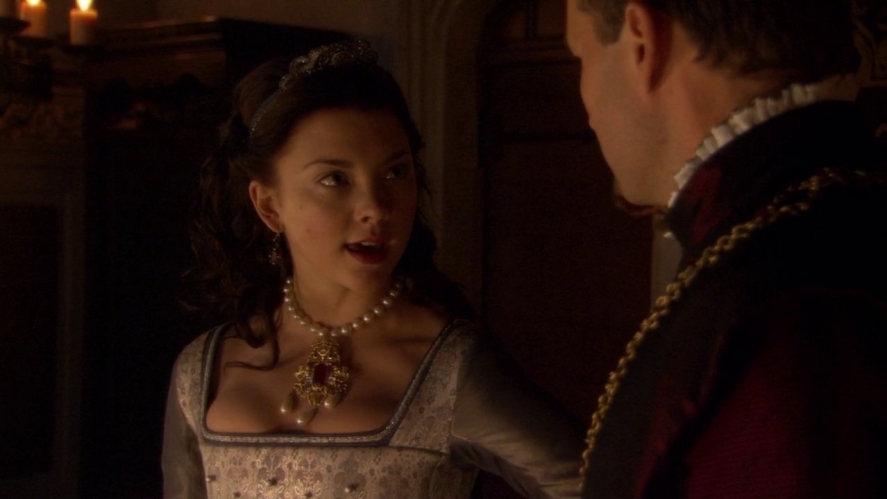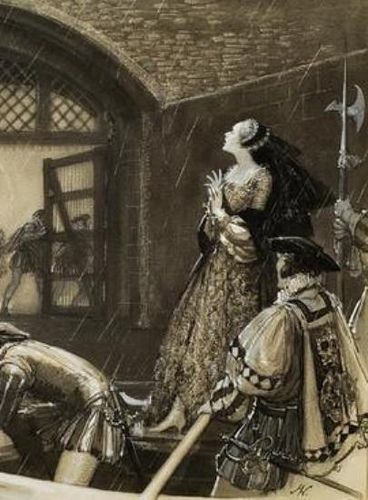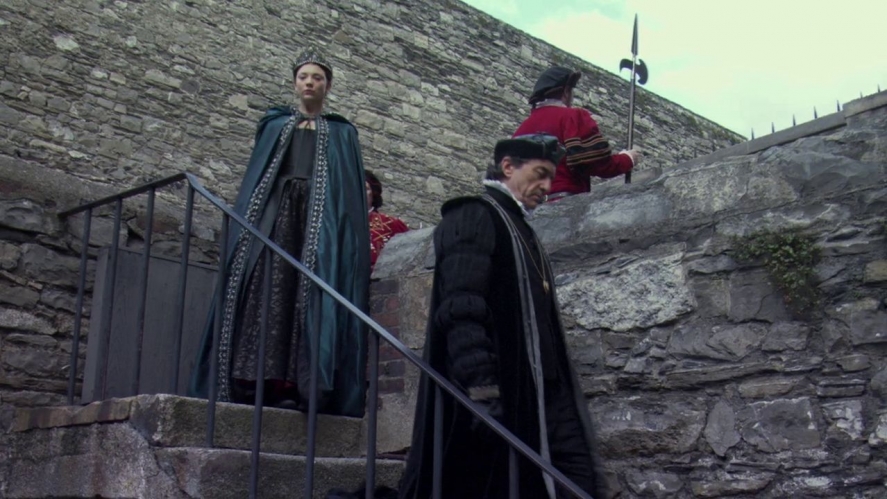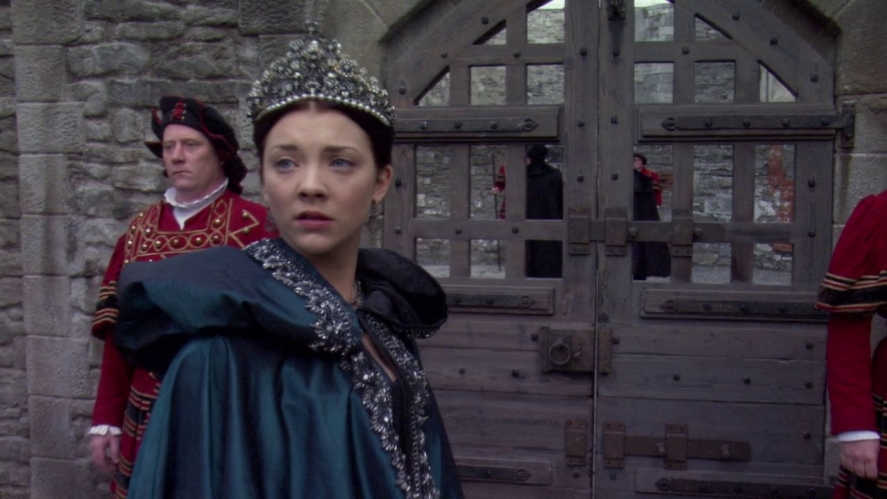The second of May in the year 1536 began for Queen Anne Boleyn as any routine day. Accompanied by her inner circle, Anne watched a game of tennis at Greenwich Palace. Then the king’s messenger approached and apprised her of her husband’s order to present herself before the Privy Council. At that time, Anne was still unaware of the arrest of her brother, George Boleyn, who had been taken to the Tower from Whitehall. As nobody or few people at Greenwich knew about George’s imprisonment, everything must have been arranged as discreetly as possible.

The Imperial ambassador Eustace Chapuys wrote to Charles V, Holy Roman Emperor, on the 2nd of May:
“The Concubine’s brother, named Rochefort, has also been lodged in the Tower, but more than six hours after the others, and three or four before his sister.”
The king’s order must have terrified Queen Anne, given that her royal husband had abruptly departed from the May Day joust just the previous day. A few days ago, she had committed two grave mistakes. Sir Henry Norris, who was a close friend of King Henry VIII’s and one of his Gentlemen of the Bedchamber, was a staunch supporter of both Anne and the ongoing reform in the Church. On the 29th
of April 1536, Norris had come to Anne so as to court her cousin, Lady Madge Shelton. For some reason, their long courtship had reached a stalemate, and the queen had teased Norris about it. In response to his words that he was not in a hurry, Anne had snapped:
“You look for dead men’s shoes! for if aught should come to the King but good, you would look to have me!”

Apparently, Henry Norris had been both appalled and shocked at the queen’s unprecedented speech. Back then, it was considered treason to imagine in any way a monarch’s death. Therefore, Norris must have denied that vehemently and then had taken himself out of Anne’s presence. On the same day, Anne had spotted Mark Smeaton, a talented court musician, standing near a window of the queen’s presence chamber and gazing out gloomily. As she had approached him, Anne had asked why Smeaton had been sulking, and his answer must have been something like ‘Nothing’ or ‘Nothing is wrong’. However, his lackadaisical behavior seems to have exasperated Anne’s frazzled nerves, and she had berated Smeaton for speaking to his queen so informally. In response, Smeaton had bowed to her and left. Anne would never see Norris and Smeaton again.
An intelligent and superbly educated woman, Queen Anne must have realized that these two cases with Smeaton and Norris could have been reported to Thomas Cromwell, who became her foe because of their different views on how the monies from the Dissolution of the Monasteries should have been used. After receiving a command to present herself to the royal commission, Anne could have been worried that her misconduct had become known. An intemperate woman, Anne was still a savvy lady with more than complex sophistication of her personality and common sense underpinning her demeanor. Nevertheless, Anne had made these two fatal blunders, which to me look like the slip of her tongue due to her growing panic and her desperation.
Having left the tennis match, the perturbed queen met with the king’s representatives in the council chamber. She faced her uncle, the Duke of Norfolk, as well as Sir William Fitzwilliam and Sir William Paulet. We don’t know for a certainty how this conversation happened. Anne learned about the charges leveled against her: adultery with three different men – Mark Smeaton, Henry Norris, and someone else. She was notified that Smeaton and Norris had already confessed. A shaken Anne protested and pleaded not guilty, but all her words fell on deaf ears, and the royal commission ordered her arrest. Anne was then escorted to her apartments until at two o’clock in the afternoon, and later the queen was taken to the Tower of London by a barge.
On the way to her prison, Anne had the opportunity to contemplate her escort that consisted of Thomas Howard, Duke of Norfolk (the highest peer of the English realm, Lord High Treasurer, and Earl Marshal); John de Vere, Earl of Oxford (Lord Great Chamberlain); and William Sandys, Baron Sandys of the Vyne (Lord Chamberlain and a royal favorite). Perhaps Anne wondered why Charles Brandon, Duke of Suffolk, who never approved of Henry’s marriage to her and whose late second wife, Princess Mary Tudor, loathed Anne, was not among her tormentors. It is more likely that Anne’s barge entered through the Court Gate in the Byward Tower, rather than Traitor’s Gate.

Upon their arrival, Anne was “welcomed” by Sir William Kingston, the Lieutenant of the Tower. By that time, she was on the verge of a nervous breakdown, so Anne asked whether she would be incarcerated in the dungeons like a common criminal. Kingston said that she would be lodged in the Royal Palace, ironically in the same apartments where Anne had spent the night before her coronation. According to Kingston, the queen tumbled to her knees and deluged into tears, saying something like “It is too good for me”, and then she laughed. Clearly, the jailed Queen of England could barely control herself: waves of visceral panic surged up and overmastered her, her nerves broke, and her words tumbled out hysterically.

Sir William Kingston wrote to Cromwell about Anne’s behavior upon her arrival:
“On my lord of Norfolk and the King’s Council departing from the Tower, I went before the Queen into her lodging. She said unto me, “Mr. Kingston, shall I go into a dungeon?” I said, “No, Madam. You shall go into the lodging you lay in at your coronation.” “It is too g[ood] for me, she said; Jesu have mercy on me;” and kneeled down, weeping a [good] pace, and in the same sorrow fell into a great laughing, as she has done many times since. “She desyred me to move the Kynges hynes that she [might] have the sacarment in the closet by hyr chamber, that she my[ght pray] for mercy, for I am as clere from the company of man as for s[in as I] am clear from you, and am the Kynges trew wedded wyf. And then s[he said], Mr. Kynston, do you know wher for I am here? and I sayd, Nay. And th[en she asked me], When saw you the Kynge? and I sayd I saw hym not syns I saw [him in] the Tylte Yerde. And then, Mr. K., I pray you to telle me wher my [Lord, my fa]der, ys? And I told hyr I saw hym afore dyner in the Cort. O[where is m]y sweet broder? I sayd I left hym at York Place; and so I dyd. I [hear say, sai]d she, that I shuld be accused with iij. men; and I can say [no more but] nay, withyowt I shuld oppen my body. And ther with opynd her gown. O, No[res], hast thow accused me? Thow ar in the Towre with me, [and thow and I shall] dy together; and, Marke, thow art here to. O, my mother, [thou wilt die with] sorow; and myche lamented my lady of Worceter, for by c[ause that her child di]d not store in hyre body. And my wyf sayd, what shuld [be the cause? And she sai]d, for the sorow she toke for me. And then she sayd, Mr. [Kyngston, shall I die with]yowt justes? And I sayd, the porest sugett the Ky[ng hath, hath justice. And t]her with she lawed.”
Queen Anne’s ordeal was only beginning. Kingston and her ladies-in-waiting, who were all selected by the monarch’s chief minister, would report all her words and ramblings to Cromwell. At the same time, rumor was in plenty at the Tudor court. Some said that Anne had persuaded Henry to ally with the German Protestants and, hence, they had a serious political disagreement. But most courtiers already heard about the scandalous rumor that Anne was guilty of adultery.
All images are in the public domain.
Text © 2020 Olivia Longueville





